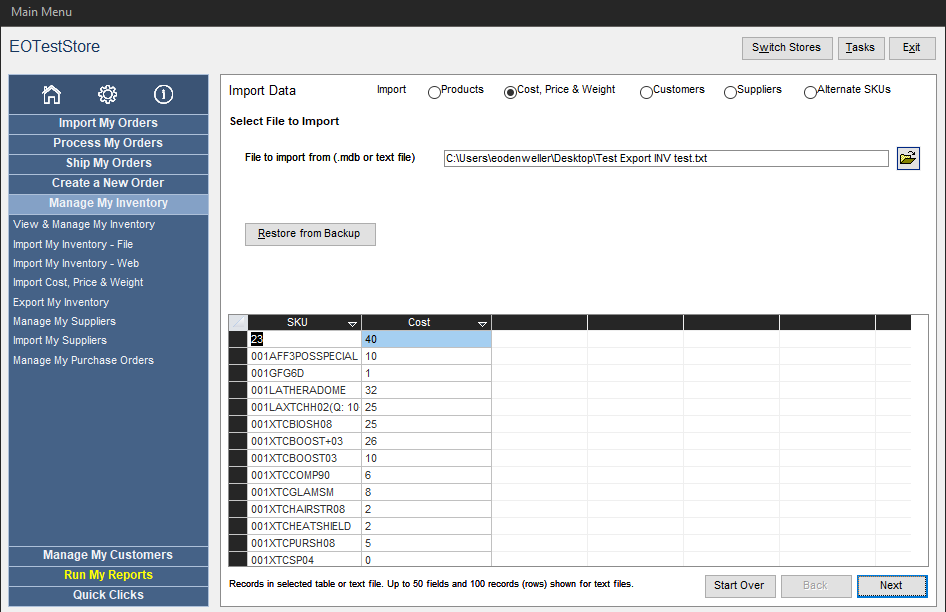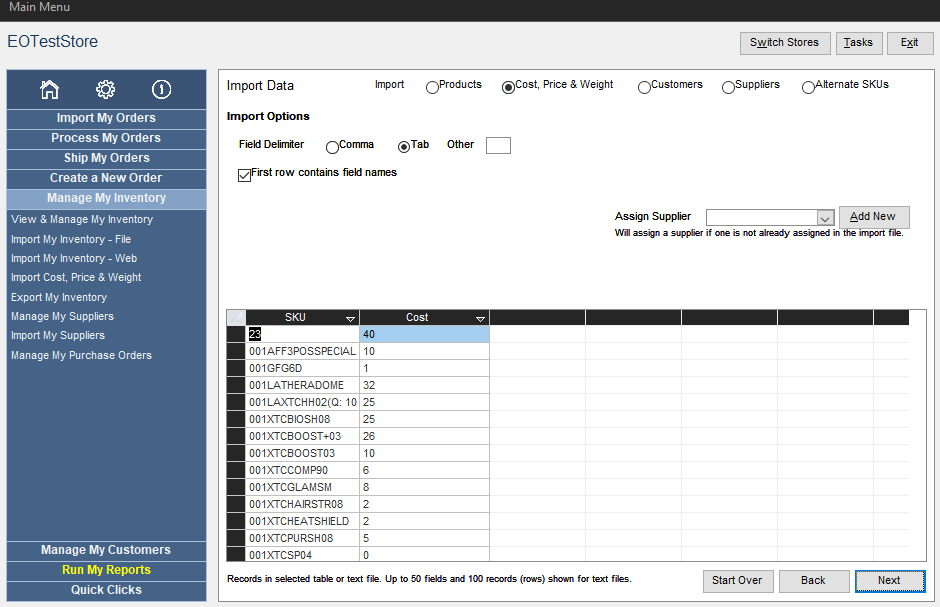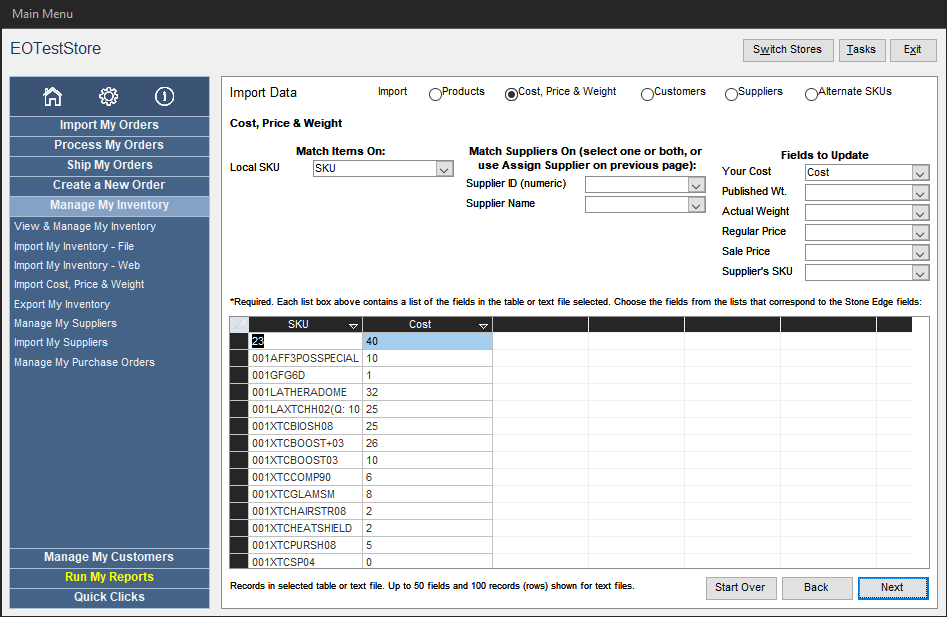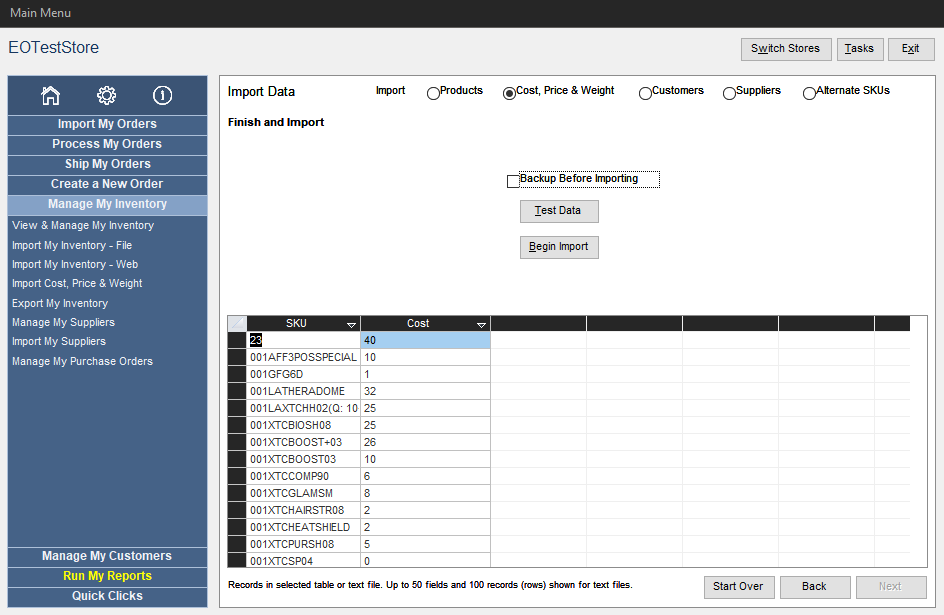Overview
- Several types of data can be imported through the Import Data screen, such as Product (Inventory), Customer, or Supplier records. Product cost and price information can also be imported via this screen.
- Data can be imported from:
-
- A tab or comma-delimited text file (Preferred)
- A table in a Microsoft Access database
- Any other format (e.g., an Excel spreadsheet or FoxPro table) can link to an Access database. For information on linking data in external tables to Access, please see MS Access documentation.
-
- When importing data from a text file, if the data contains commas, the file should be saved as a tab-delimited file, not a CSV.
- Quotes should not be present in text files, whether it is a CSV or tab-delimited file, or you will encounter errors.
- To access this screen go to one of the following areas:
Main Menu > Manage My Inventory > Import My Inventory – File
Main Menu > Manage My Inventory > Import Cost, Price & Weight
Main Menu > Manage My Inventory > Import My Suppliers
Main Menu > Manage My Customers > Import My Customers – File
- The user is led through the steps to import the various data types by a series of screens.
- This topic discusses the process of importing product cost, price, and weight information.
Description of the Screens

Import Cost, Price, and Weight: Select the File to Import tab
Select File to Import Tab
Import Radio Button
- The Cost, Price & Weight radio button is selected by default
File to import from (.mdb or text file) Field
- Enter the path to the file containing the product information
- The program displays up to 50 fields in the file and the first 100 records at the bottom of the screen
Folder Button
- Select this button to navigate to the location of the file containing the product information
Restore from Backup Button
- Select this button to restore from a previous backup, if one was created at the last step of the process
Start Over Button
- Returns to the Select File to Import tab
Next Button
- Select this button when ready to proceed to the Import Options tab
Import Options Tab

Import Data screen: Import Options tab for importing Cost, Price, & Weight information
Field Delimiter Radio Buttons
Comma Radio Button
- Select this button if commas separate the fields in the input file
Tab Radio Button
- Select this button if a tab separates the fields in the input file
Other Field
- Enter the character used to separate the fields in the input file
First Row Contains Field Names Check Box
- Select this box if the first row in the input file contains a header record with field names
Assign Supplier Drop-down List
- Select a supplier to assign to product records that do not already contain a Supplier ID or Supplier Name value
- This Supplier automatically becomes the Primary Supplier of the product
Add New Button
- Click this button to add a new supplier record “on the fly.”
Data in Text File or Database Table
- This section displays up to fifty fields and the first one hundred records of data in the input file.
Start Over Button
- Returns to the Select File to Import tab
Back Button
- Returns to the previous tab
Next Button
- Select this button when ready to proceed to the Cost, Price & Weight tab
Cost, Price & Weight Tab

Match Items On (select one):
- Choose whether to match product records between the files based on the Local SKU or Item Name fields.
- Local SKU is the best choice because SKUs must be unique, whereas products may share the same name.
- Clear the field that is not used.
Match Suppliers On:
- Select Supplier ID and/or Supplier Name OR leave these fields blank and use the Supplier specified on the previous tab instead.
- Supplier IDs in the external file must be numeric, and they must be the identical Supplier IDs that exist in OMS.
Fields to Update
- Select or clear the values in these drop-down lists to control which fields are updated.
- The possible choices are Your Cost (Supplier’s unit cost field), Published Wt., Actual Weight, Regular Price, Sale Price, or Supplier’s SKU.
Data in Text File or Database Table
- This section displays up to fifty fields and the first one hundred records of data in the input file (not labeled as such).
Start Over Button
- Returns to the Select File to Import tab.
Back Button
- Returns to the previous tab.
Next Button
- Select this button when ready to proceed to the second page of the Finish and Import tab.
Finish and Import Tab

Backup Before Importing Check Box
- Select this box to make a backup copy of the affected tables before the import is started
Test Data Button
- Select this button to have the program check for errors before starting the import process
Begin Import Button
- Select this button to start the import process
Start Over Button
- Returns to the Select File to Import tab
Back Button
- Returns to the previous tab
